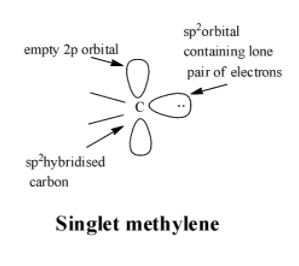
What is the hybridization of carbenes?
(a)
(b)
(c)
(d)
Answer
483k+ views
1 likes
Hint: Carbenes are those compounds in the carbon consists of total six electrons in its valence and the remaining two electrons are present as unpaired electrons and in singlet carbenes, one s and two p orbitals of the same shell of an atom mix to form three equivalent orbital and in triplet carbenes, one s and one p orbital of the atom mix to form two new equivalent orbitals. Now you can easily identify its hybridization.
Complete answer:
First of all ,let’s discuss what carbenes are. Carbenes are the neutral divalent species in which a carbon is covalently bonded to two atoms and has got two non-bonding orbitals having two electrons between them.
In simple words, we can say that the carbenes contain a neutral carbon atom having six electrons in the valence shell out of which two are unshared.
Carbenes are highly reactive species having a very short life period.
The carbenes exist in two distinct states;
1. Singlet carbenes: These are the carbenes in which unshared electrons are paired(i.e. they are present in one orbitals).
2.Triplet carbenes: These are the carbenes in which unshared electrons are not paired(i.e. they are present in different orbitals).
Example: methylene carbene can have either of the following two structures depending upon its mode of formation.
Triplet carbenes present biradicals i.e. divalent free radicals.
In singlet carbenes, the central carbon atom is in a state of

In triplet carbenes, the central carbon atom is in a state of

So, thus the hybridization of singlet carbenes is
Hence, option (a) and (c) both are correct.
Note:
The triplet carbenes are lower in energy and therefore, more stable than singlet carbenes because in triplet carbenes the electrons occupy different orbitals and the electron repulsion is much less than that in case of singlet carbenes where the repulsions are more due to the presence of electrons in the same orbitals.
Complete answer:
First of all ,let’s discuss what carbenes are. Carbenes are the neutral divalent species in which a carbon is covalently bonded to two atoms and has got two non-bonding orbitals having two electrons between them.
In simple words, we can say that the carbenes contain a neutral carbon atom having six electrons in the valence shell out of which two are unshared.
Carbenes are highly reactive species having a very short life period.
The carbenes exist in two distinct states;
1. Singlet carbenes: These are the carbenes in which unshared electrons are paired(i.e. they are present in one orbitals).
2.Triplet carbenes: These are the carbenes in which unshared electrons are not paired(i.e. they are present in different orbitals).
Example: methylene carbene can have either of the following two structures depending upon its mode of formation.
Triplet carbenes present biradicals i.e. divalent free radicals.
In singlet carbenes, the central carbon atom is in a state of

In triplet carbenes, the central carbon atom is in a state of

So, thus the hybridization of singlet carbenes is
Hence, option (a) and (c) both are correct.
Note:
The triplet carbenes are lower in energy and therefore, more stable than singlet carbenes because in triplet carbenes the electrons occupy different orbitals and the electron repulsion is much less than that in case of singlet carbenes where the repulsions are more due to the presence of electrons in the same orbitals.
Latest Vedantu courses for you
Grade 11 Science PCM | CBSE | SCHOOL | English
CBSE (2025-26)
School Full course for CBSE students
₹41,848 per year
Recently Updated Pages
Master Class 9 General Knowledge: Engaging Questions & Answers for Success

Master Class 9 English: Engaging Questions & Answers for Success

Master Class 9 Science: Engaging Questions & Answers for Success

Master Class 9 Social Science: Engaging Questions & Answers for Success

Master Class 9 Maths: Engaging Questions & Answers for Success

Class 9 Question and Answer - Your Ultimate Solutions Guide

Trending doubts
State and prove Bernoullis theorem class 11 physics CBSE

What are Quantum numbers Explain the quantum number class 11 chemistry CBSE

Who built the Grand Trunk Road AChandragupta Maurya class 11 social science CBSE

1 ton equals to A 100 kg B 1000 kg C 10 kg D 10000 class 11 physics CBSE

State the laws of reflection of light

One Metric ton is equal to kg A 10000 B 1000 C 100 class 11 physics CBSE




